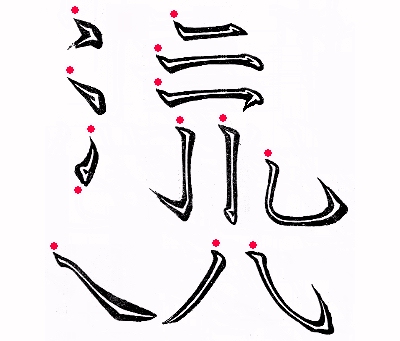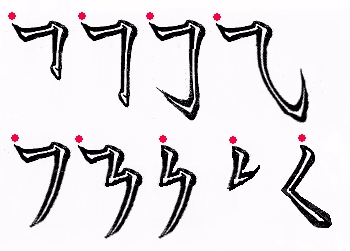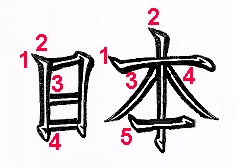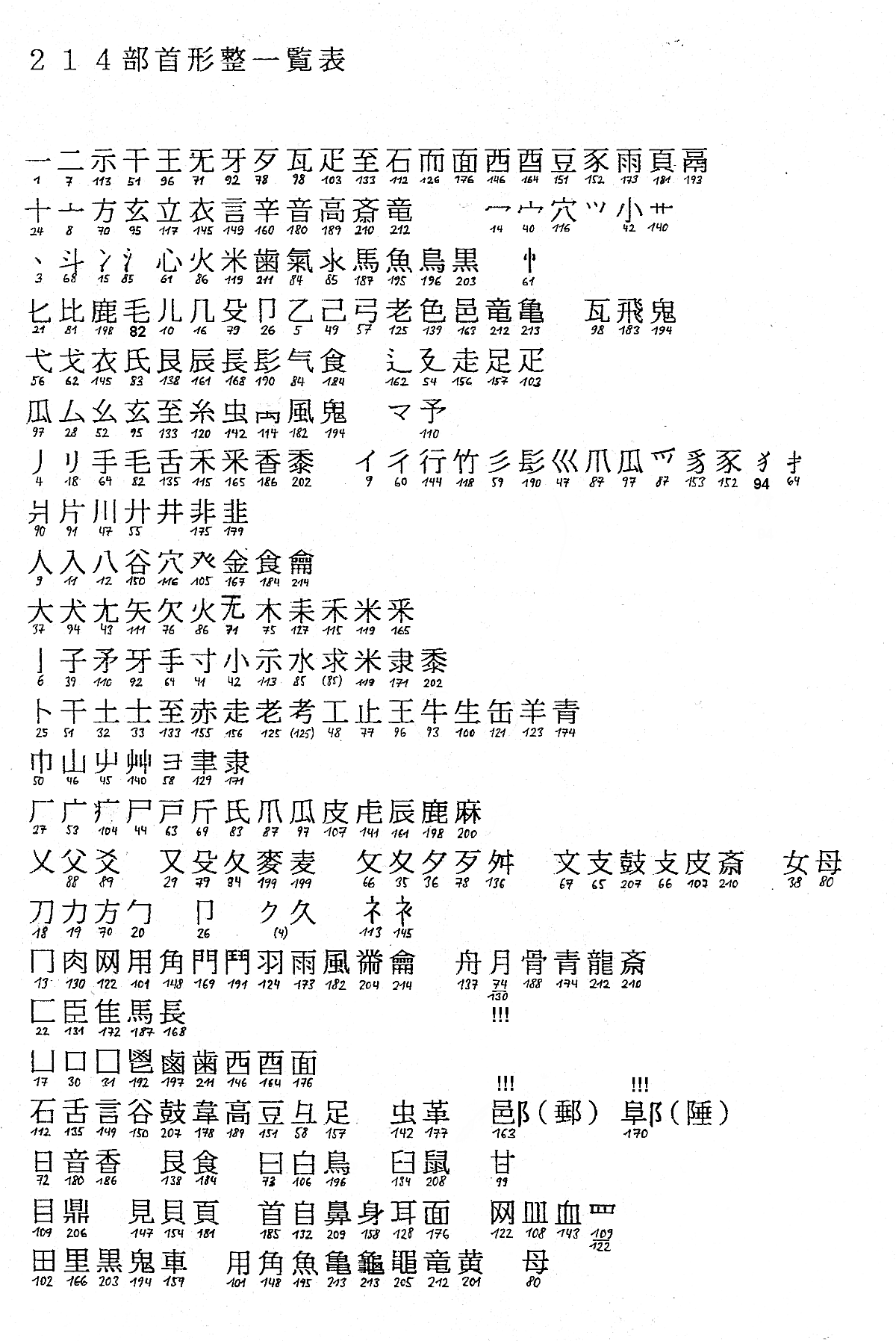Japanese Characters
Kanji 漢字 - The Word Characters
|
OK, welcome to the REAL thing :) Don´t feel intimidated, everyone can learn Kanji!
You could memorize so many words in Your language, so You can memorize many words in another, too.
Indeed, kanji are the most difficult part of East Asian languages, but take it as a challenge. There is a system that You have to grasp, and then You can write all characters and whole texts, even when You actually do not understand one single word :) A Bunch of StrokesThe single stroke means nothing, it is their combination making the sense. But, the single stroke is very important for that meaning; it would be like omitting a letter, like "tough" and "though", they sound alike and look alike, but have no meaning in common!Don´t be afraid: there are only a handful of basic strokes to write ANY kanji - see more below :) The Chinese OriginsKanji 漢字 came to Japan from the Chinese "Hàn-zì" 汉字 - You can see and hear the similarity! China uses them for more than 4000 years now. It can be said that it is the oldest character set still in use, almost unchanged! Very much the same way as we use Latin words (e.g. all "X-tion") in all Western languages, almost unchanged.Japan, Korea, and Vietnam "imported" these characters like we reused Latin letters from the Roman Empire. None of these countries had an own character system. Vietnam replaced Hàn-zì with Latin letters with the French colonization, and Korea was the bridge to bring Hàn-zì to Japan (which becomes clear when You compare Korean and Japanese readings of Hàn-zì/Kanji). This cultural "import" was a metter of several hundred years, starting around 1000 A.D. It is often forgotten that even the Chinese Hàn-zì underwent a developement in pronounciations, and within China, they are read in many different dialects. Depending on that stage of development, a Kanji was adopted by Japan (often via Korea!) and thus "frozen". Japan and Korea derived own character systems from the Hàn-zì. Japan created the two syllable systems Hiragana and Katakana from those kanji that had a fitting reading... Kanji in Japan were "re-used" in a language completely different from Chinese. In Latin letter languages, we know the same effect: the same letters may be pronounced much different, e.g between English and German. So, to overcome that "mismatch", kanji were pronounced in two major ways: "ON" = Sino-Japanese (from the Chinese, but omitting the Four Tones and adapting to Japanese tongues), and "KUN" = "purely" Japanese, when they had an own word for the Chinese counterpart; that Japanese word generally sounds entirely different. When the first European colonizers came to East Asia, these character systems where already a strong tradition. In fact, Japan is the only Asian country that never could be colonized, neither by China nor by the West - all other countries came under colonial influence at the imperial era between 1600 and 1945. Japan on the contrary, after a first opening to trade, shut all doors to any foreigners (including Chinese!) for the entire Edo era (1603-1867). The single exception was the ilse of Deshima, reserved for the Dutch East Indian Company. At that era, the import of kanji stopped. Japan became the "locked country". The Chinese character system, still "re-used" by Japan and Korea, arises astonishment and respect due to its sheer existence - because it is so complicated and has so many characters. And, it intimidates all who cannot read them. But, keep in mind that in ancient times, all over the world, only few people ever could read and write. For to be literate means having power - and that is the "problem": a government has a natural tendency to limit power sharing. One way to exclude average people from power is a "secret communication system" that is hard to learn. In the end, only imperial and aristocratic families could afford such education. Ordinary people, over 90% farmers, had to struggle for life, and could read only some bascis, if any. Modern "Reforms"The Meiji era (1868-1912) reopened the country - under the pressure of the US Navy :) The Japanese saw that they no longer could be safe by obsurity and turned around 180 degress: they were eager to learn anything from the West, which was nontheless still a potential enemy.By studying the West, Latin letters ("ROOMAJI" ロ-マジ) became vital for Japanese to learn foreign languages. But in return, it came out that it is impossible to reform the Kanji system, for several reasons:
1. How to Write Kanji, and How to Find Kanji in a DictionaryKanji Graphemes - a Unit of Harmony
The classic writing utensil still is the brush, not the pencil!
Read mroe about Japanese on a PC
here.
A group of strokes is referred to as a "grapheme", a "pattern" that appears many times, in other kanji as well. These graphemes can be quite complex, but do never change, so they can be memorized - and mixed up.
Behind all graphemes, there are only a handful of basic strokes: the red point marks that starting point of the brush,
the width of the stroke marks the pressure put into the brush:
The stroke count of a grapheme is not always easy to identify, because a stroke can change its direction but still count as one single stroke:
These strokes are combined to graphemes and complete kanji: the red numbers mark the order of the strokes and their starting points for the brush:
Graphemes are "sub units" inside of the kanji. A kanji can consist of just one grapheme, but often of many. 日 → 明 ... 曹 ... 鈤 ... The more cmplex a kanji is, the more emphasis is put into the balance of the strokes. NOTE: kanji can be mixed up easily! Be careful... 手 = Hand, 毛 = Hair
If You once learned these basics of kanji writing,
You are in fact able to write any kanji text as a copy, even when You know literally NOTHING
about readings, meanings or grammar - You can copy blindly :)
A special group of graphemes, that formed the classic dictionary index for kanji, are the radicals. E.g. radical No.9: "Man, Human" 人, 亻 → 仍仁 ... 会 ... 但佇 ... 僳僴 ... 儾 There are 214 classic radicals. They are not out of date, they are still in use, even in UTF8! Some radicals have several variants, but not many, only two or three. When You look up a kanji using the radical index, You do not need to know reading, meaning or grammar. It is just the graphic that must match perfectly:
Kanji Indexes in The DictionariesYou can use these indexes only when You learned the basic of strokes, radicals and stroke counts!Because kanji are very complex, modern dictionaries have at least the radical index, but also some more ...
My Personal Radical IndexThe basic problem always remains: there are so many kanji that can be mixed up. So I made my own system, but only for the 214 classic radicals: I sorted them by similarity
Yes, You are free to use it :) 2. How to Read KanjiJapanese is based on the syllables systems Hiragana and Katakana. Do it like Japanese kids do at school: first learn Kana, then Kanji, using Furigana (small Kana to the right of the kanji) as reading helps.The rest is memorizing. That takes a lifetime ... Although there is some logics behind how read kanji sharing the same graphemes, that rule has many exceptions, so You better do not rely on "similarity" for pronounciation. At least, some dictionaries take care of it and sort by similar readings and graphemes, too, like Langenscheidts´ "Kanji and Kana".
On- and Kun Reading; Furigana Reading Helps"KAN-JI" is the ON reading of 漢字. Every kanji represents at least one syllable. But, neither strokes nor graphemes give a clear hint how to read the kanji in the context. Strokes are not letters that would indicate it.The system is completely different from any Western "character setup": start from zero, this is another concept! Most Kanji have at least the following two "types" of readings:
Phonemes and HomophonesPhonemes are pronounciations of words or parts of it. Homophones are words sharing the same pronounciations but having different meanings.Example: note that the Kana version of this sentence is perfectly the same... "Hashi no Ushiro ni wa Kumo" - "Look, behind the bridge, the cloud!"
"Hashi no Ushiro ni wa Ku-mo" - "Look, behind the chop sticks, the spider!"
"Hashi no Ushiro ni wa Ku-mo" - "Look, behind the bridge, the spider!"

Japanese Names"So let all Your hopes go ..." - no more rules here. Nothing but traditions. You only get to know it when You actually live in Japan.When Japanese have a baby, they may take a traditional name and give it to the child. Or they may take any rare character and give that a "new" reading...no dictionary will tell You ... ... but this: "Japanese Names", by P.G. O´Neill, Weatherhill, New York, 1972. My print is from 1993, and it is reprinted over and over.
|


 日本, "Ni-Hon" = Japan.
日本, "Ni-Hon" = Japan.
